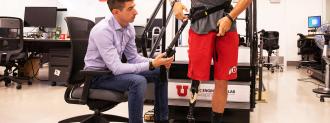University of Utah engineers have built a robotic exoskeleton that gives people with prosthetic legs a power boost that makes walking less difficult.
“It’s equivalent to taking off a 26-pound backpack [while walking],” lead researcher Tommaso Lenzi said in a press release. “That is a really big improvement.”
The challenge: About 220,000 people in the U.S. have had above-knee amputations, meaning their leg was amputated somewhere between the knee and hip.
These surgeries remove a significant portion of the leg’s muscles, which makes walking difficult even with a prosthetic. People with above-knee amputations move 8.6% slower than people without amputations, but even so expend 65% more energy and consume 49% more oxygen.
“The exoskeleton’s AI understands how the person moves.”
Dante A. Archangel
A robotic exoskeleton: Lenzi’s team has now developed a lightweight robotic exoskeleton that helps people with above-knee amputations walk with less effort.
During a phase 1 trial, it dramatically reduced wearers’ energy expenditure, without causing noticeable changes in their gait balance or stability.
“We’re very close to what an average person would expend at the same speed,” Lenzi said. “The metabolic consumption is almost indistinguishable from that of an able-bodied person, depending on the fitness level.”
“There’s nothing that will ever replace a flesh-and-bone leg, but this comes pretty close.”
Stan Schaar
How it works: The robotic exoskeleton is worn around the waist and wraps around the thigh of the affected leg. Sensors feed data to the device’s AI, and the AI uses that data to control the battery-powered motors that help the leg move.
“The exoskeleton’s AI understands how the person moves and assists how the person moves,” co-author Dante A. Archangel said.
Lenzi compares this to how the motor of an e-bike assists riders when they need to pedal up a hill — the person wearing the exoskeleton is still walking, but they aren’t having to put as much effort into it.
The feedback: Six people with above-knee amputations participated in the Utah team’s phase 1 trial, and they seem impressed by the robotic exoskeleton.
“The first time I used it, it was like my muscles were totally fused with this exoskeleton, and it was helping them move faster,” retired computer administrator Stan Schaar said.
“It helped my leg to relax and just move forward and walk,” he continued. “I could probably walk for miles with this thing on because it was helping my muscles move.”
He’d be able to do it without stopping to recharge, too.
“The battery life depends somewhat on the conditions, but on average it lasts for ~30,000 steps, which is about 4 hours of continuous walking at a quick pace,” Lenzi told Freethink.
The next steps: It’s not clear what a commercial version of robotic exoskeleton might cost, but for now, Lenzi and his team are focused on further refining the device using a $584,000 grant from the National Science Foundation.
“There’s nothing that will ever replace a flesh-and-bone leg, but this comes pretty close,” Schaar said. “I hope they get this thing on the market soon.”
We’d love to hear from you! If you have a comment about this article or if you have a tip for a future Freethink story, please email us at [email protected].





